Disclaimer: This post may contain affiliate links which means I may receive a small commission from purchases made through links. However, these are products that I would wholeheartedly recommend to my family and friends regardless if I make a small commission at no cost to you as a consumer.
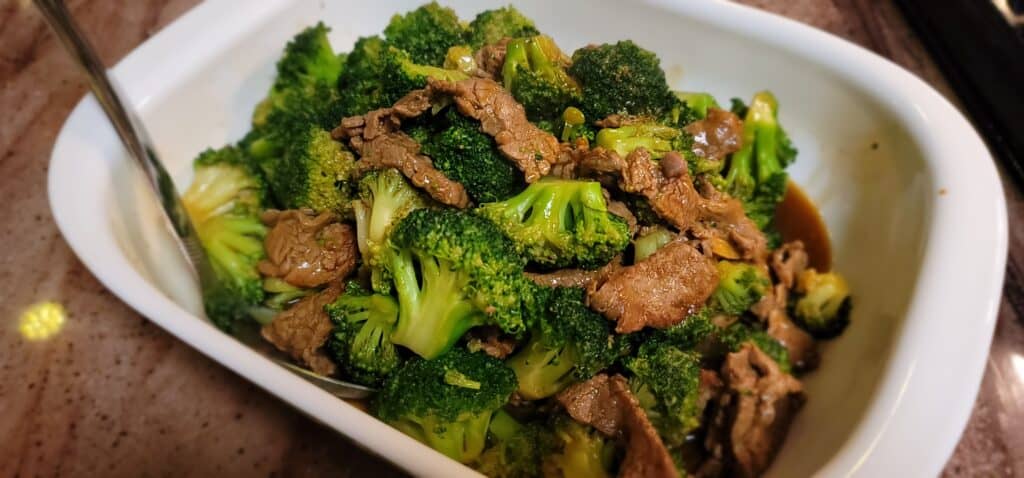
5 Secrets Ways to Tenderize Beef for Stir Fry
What Is The Obsession On Stir Fry?
Growing up in an Asian household, stir fry dishes for dinner is a stable in the family. I’m talking about different variations of this style of cooking at least five times a week. I’m thinking the word “stable” might even be an understatement. With a simple formula of meat plus vegetables, the possibilities are endless. It has earned a place on our dinner table night after night and it is definitely not by chance. For the meat portion of the formula, beef is our go-to option. It is vital that we know how to tenderize beef for the best stir fry dishes.
The Meat Component
Beef is usually the go to option mainly because you don’t need to worry about undercooking it. I can’t say the same for pork and chicken, even though I like them just as much. It is extremely easy to prepare, no need to break out the meat tenderizer and use complicated wet brining. It is also relatively easy to thaw before dinner time, for days you forgot to take it out of the freezer the night before, I am sure you could relate.
The most popular cut of meat is flank steak. It is affordable, widely available, and easy to prepare! Having tenderize meat does not mean you’ll need to use cuts like filet mignon if you implement these tips and tricks.
Another great option is chuck steak (chuck roast) or skirt steak. It is even more affordable compare to flank steak. However, since it is a tougher cut, we need to know how to prepare it . Note: Tough cuts might need more time for these tips to work.
In this article, I will share with you my top secret tips and tricks to tenderize meat! These are things that the majority of Chinese restaurants (or takeout places) utilized when preparing their meat.

1. Correct Way to Cut Beef
The way the beef is cut has everything to do with how chewy (or not) it will be after it is cooked. The key to cutting it correctly is to cut against the grain. These are long connective tissue. The longer the grain is, the hard it is to break apart the muscle fibers when chewing.
Flank steak usually comes in somewhat of an oval shape. The grain usually runs along the long side. So slicing it along the short side is the right way to go.
Slice thinly to 1/8 of an inch thick or julienne to a matchstick shape. The shape you cut it into largely depends on the shape and size of other ingredients that will be in the same dish. Thinner cut meat makes for quick cooking. It also helps with getting nice sear on more of the meat, which is flavor.
Be sure to use a sharp knife for this job. Here is an article that goes into more detail on this.
Tips: If you wash your beef before slicing, be sure to pat your meat dry with paper towels so it doesn’t slip everywhere on the cutting board. It will be easier to handle.
2. Add Water to Increase Lightness
Beef could absorb an insane amount of water after it’s sliced since it has more surface area where water could get in. After enough water is absorbed into the beef, you’ll feel the lightness of the meat.
There are 2 ways to add water to your beef
Ice Bath
First method is to rinse your sliced beef under really cold running water or put it into a big bowl of ice bath for 30 to 45 seconds. Then simply drain off excess water and you are good to go.
Sprinkles
Second method, which is my preferred option, is to add small amounts of water directly into the bowl with the sliced meat. I usually do this after my main marinates (like other sauces, sugar, etc.) are done, then water as a second “marinate”. If you are adding water to the meat, your main marinates might need to be tweaked to be a wee bit stronger so as to not dilute the finishing taste. The amount of water needed depends on the condition of the meat. A rough ratio would be a 1/4 cup to 1 pound of meat.
Now I am sure you have heard this before, Asian cooks don’t use exact measurements. We sometimes rely on our senses. Yep, you got it, we could “eye-ball” it.
Start adding a small amount of water (a tablespoon or so) into the meat, then start mixing it around for a few seconds. Then check the bottom of the bowl to see if there is excess water that is not being absorbed. If most of the added water is absorbed, then repeat the process until you start to see a little bit of water starts pooling at the bottom. It’s that simple!
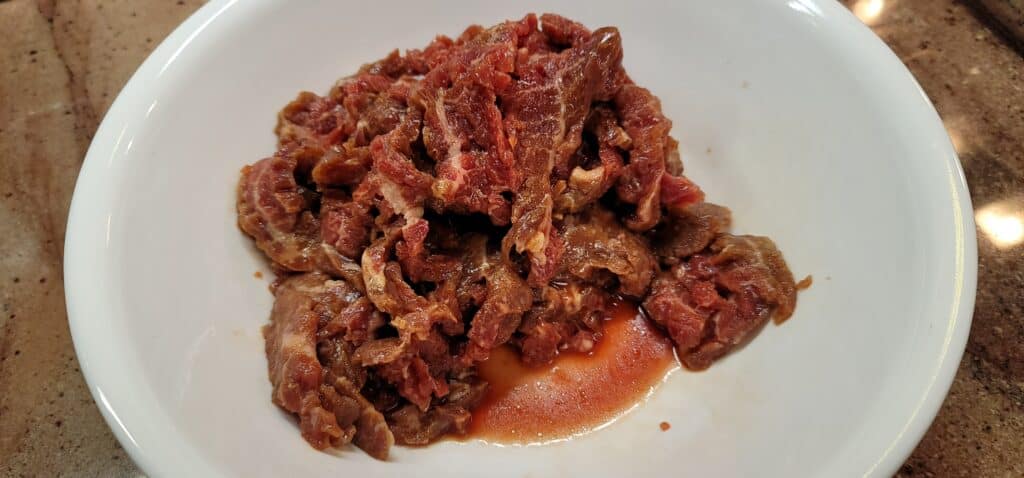
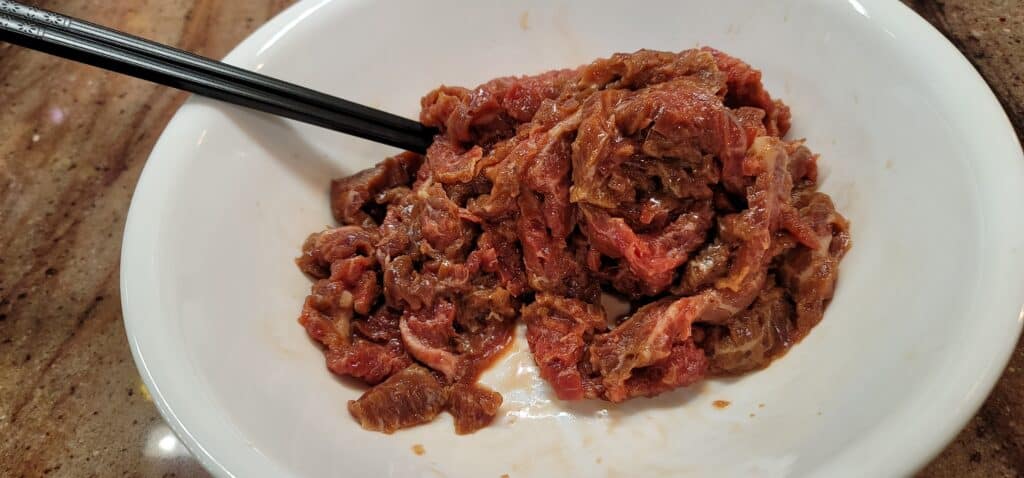
3. Baking Soda to Tenderize Meat
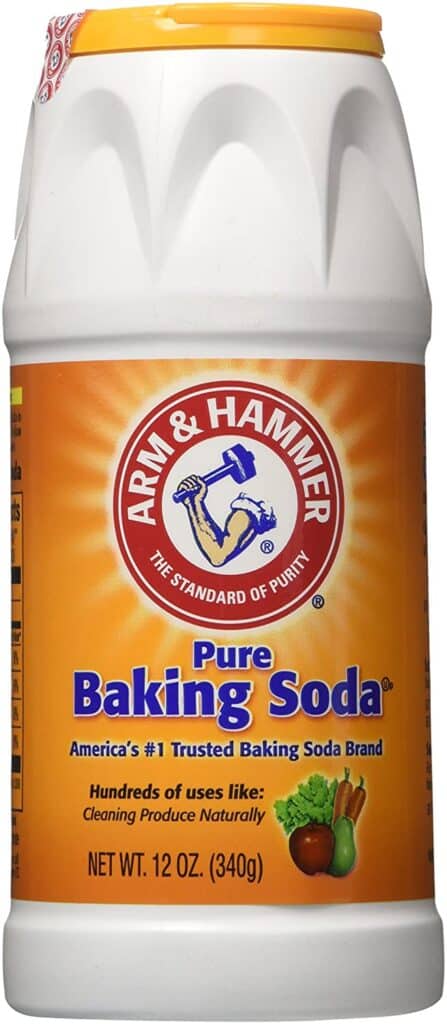
The majority of Chinese restaurant uses baking soda to tenderize meat. Baking soda is one of their top-secret weapon to tenderize meat.
A tiny little bit goes a long way. Roughly 1/8 of a teaspoon for 1 pound of meat is enough. If you use a tougher cut of meat, like chuck steak, you could increase to 1/4 of a teaspoon per 1 pound of meat. You do not want to use more than that since baking soda alkalizes the meat, and using too much could change the taste and texture of the meat.
Next, we need to think about how to apply this in our process. You could sprinkle it directly onto the meat, however, once it touches the meat, it will absorb into it right away, and with that little amount, you will not be able to spread it to all the meat effectively.
My preferred method is to incorporate it into some kind of liquid, then pour it in, that way it will have a chance to spread out more evenly. If you are using water, from No. 2 above, you could add baking soda to it. You could also incorporate it into any sauce(s) you’ll be using to marinate the meat, like soy sauce, oyster sauce, etc.
Consideration: Some like to use acidic ingredients, like citrus juice (lemon juice or lime juice) as ways to tenderizing meat. Or maybe you are using an acidic marinade. In those cases, only marinating meat for a short period of time, at most several hours for beef. The acidity will slowly change the texture of the meat and breaking it down too much.
4. Spa Treatment for Optimal Absorption
No, not for you silly! You are the masseuse/masseurs to your meat. No worries, after you put all the effort into your delicious meal, you could get a massage from your lovely family member.
Okay, back to the meat. In order to get anything to absorb faster and deeper into the meat, spending a couple of minutes mixing and massaging it is important. Whether it is the water we want to mix in or the sauces of your marinate. Simply use your hand (aka the greatest kitchen tool you will ever have) and start mixing everything in the bowl. You could also gently squeeze the meat while mixing. The heat from your hand will also help drives the ingredients into the meat.
It is important not to overdo this for too long though since you don’t want to warm up the meat too much. I do admit that I sometimes just use a spoon to mix everything together and that works too, as long as more time to let it sit and marinate. Spa treatment is still the go-to method.
5. Corn Starch and Oil for Finishing Touches
We need to create a fuzzy coating for the meat.
The purpose of this is to:
A) Lock in the marinate and moisture. If you don’t do that, after you let the marinated meat sit for a bit, you might see a small amount of liquid at the bottom of your bowl. These are the yummy goodness you want inside of the beef and not anywhere else.
B) To prevent the meat from the shock of high heat during cooking which could make the texture rough. You want to cook things with high heat for short periods of time, which leaves room for a little margin of error. Having some coating on the meat will help a bit with this.
Have at least one of these:
Cornstarch
Cornstarch is essential for this process. Roughly 1 tablespoon per pound of meat would be the rule of thumb. However, most home cooks don’t use exact measurements. There are different variables that could contribute to the condition of the meat, which could dictate how much should be used.
This is where we want to put in little by little, mix it together and see how it looks. The consistency we are looking for is a little sticky but not too much. Visually, it should be a little bit of white coating but seeing chunks of white paste.
Cooking Oil
Cooking oil could be used to finish this process. Just like the corn starch is to coat the meat, oil is now coating the cornstarch to make sure everything stays in place. You could use any type of oil. I often use either avocado or olive oil. After the corn starch is mixed in to your satisfaction, just add a small splash of oil and mix that in.
For a list of best oil to use, please see this blog post.
And Now We Wait
Combining these tips and trick with your favorite marinate will give you the best result. Set this aside for at least 15 minutes before cooking to let it work its magic. If you are preparing this ahead of time (hours or even a day or two before cooking), put on some plastic wrap to cover it and have it sit in the fridge until you are ready to cook.
Bonus Tips: Batch Cooking for the Win
I often (by that I mean all the time) prepare a huge batch of marinated meat and freeze it for later use. I would get a huge amount of flank steak from the wholesale club like Costco, especially if when it’s on sale. Marinate the meat using these tips. Separate into 1 pound portion. Put into Ziploc bags. Lay it flat to freeze so that after it’s frozen, it is in a thin profile, which helps with quick thawing.
Main purpose of this is to use it in dishes for a quick weeknight dinner. Take a portion of this juicy meat out of the freezer. Leave it on the counter for about an hour or so to thaw. Be careful not to leave it out in room temperature for too long though, but an hour or two is safe, as most of the time you should leave cold meat out in room temperate before it’s cooked. Cut up some fresh vegetables to go with it.
Preparing weeknight dinner is never easier than that. Bonus that it is a health meal that is freshly cooked!
That’s all there is to it! You’ve got this!!
Following these simple tips could pay off big on stepping up your game and having the most tenderized beef as can be. Please leave a comment below and let me know if this works out for you. If you have any questions all at, let me know in the comment section as well.





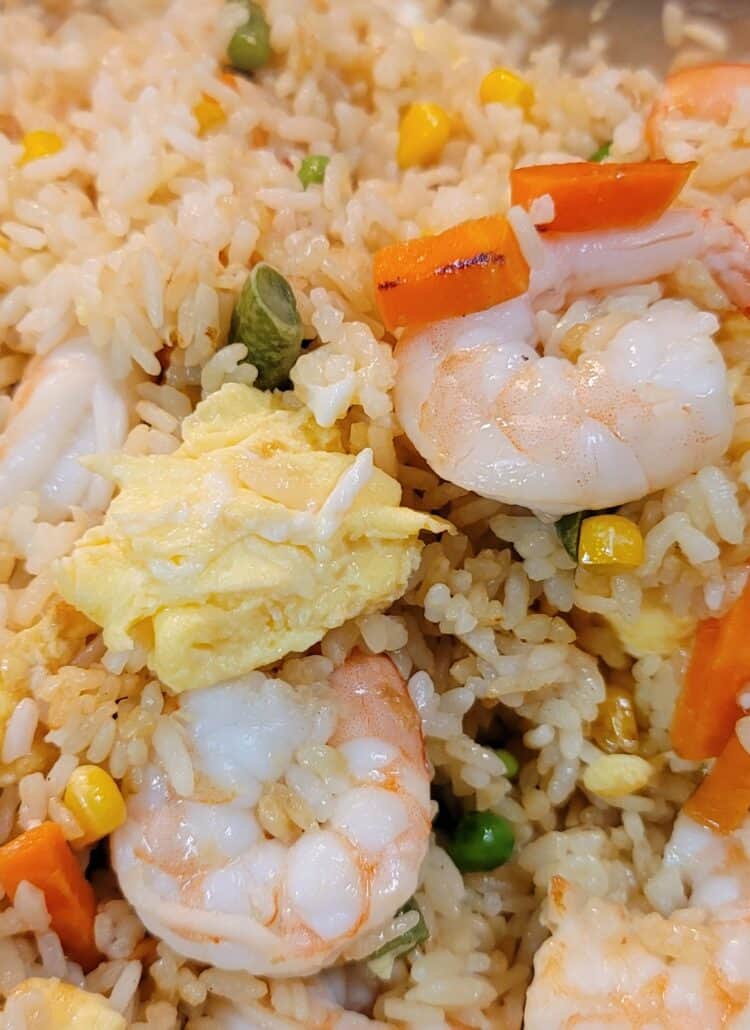


[…] I use this chef’s knife exclusively when cutting meat this thin slices. Here is an article with more detail on how. […]